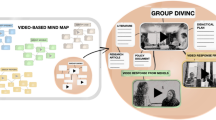Abstract
Technologies such as videoconferencing used for distance education are creating ways for high schools to extend their learning communities to connect youth with professional communities of practice in ways that approximate the face-to-face interactions in traditional classrooms. These technologies are often touted as a way to augment course offerings and curricula, particularly those needed for college-going. The use of videoconferencing technologies alone, however, does not ensure that the desired forms of interaction will occur particularly given their reliance on traditional banking-model pedagogies and literacies. In this article, we focus on college bound Black and Latino/a youth from under resourced urban communities and their negotiations of new technologies, multiple literacies, and traditional pedagogies within a music education learning community extended through videoconferencing technologies. Employing a multicultural feminist critical theoretical framework, we unearth the ways Black and Latino/a youth’s identities as active learners and college-bound musicians shape, and are shaped, in the interplay of new technologies, multiple literacies, and traditional pedagogies within a music education classroom.
Similar content being viewed by others
REFERENCES
Alvermann, D. (Ed.). (2002). Adolescents and Literacies in a Digital World. New York: Lang.
Budd, M. (1989). Music and the expression of emotion. Journal of Aesthetic Education 23(3): 19-29.
Burke, C., Lundin, R., and Daunt, C. (1997). Pushing the boundaries of interaction in videoconferencing: A dialogical approach. Distance Education 18(2):350-359.
Caputo, V. (1994). Add technology and stir: Music, gender, and technology in today's music classrooms. Quarterly Journal of Music Teaching and Learning 4 & 5 (4 &1):85-90.
Cruz, C. (2001). Toward an epistemology of a brown body. Qualitative Studies in Education 14(5):657-669.
Damarin, S. (1998). Technology and multicultural education: The question of convergence. Theory Into Practice 37:11-19.
Evans, T., and Grace, M. (1995). Distance education as the gendered privatization of learning. Journal of Curriculum Studies 27:299-315.
Freire, P. (1973). The pedagogy of the oppressed. New York: Seabury.
Foucault, M. (1984). The means of correct punishment. In P. Rabinow (Ed. and Trans.), The Foucault Reader (pp. 188-205). New York: Random House.
Gee, J. P. (1996). Social linguistics and literacies: Ideologies in Discourses. Philadelphia: Falmer Press.
Glasser, B. G., and Strauss, A. L. (1967). The discovery of grounded theory: Strategies for qualitative research. Chicago: Aldine.
Grosz, E. (1993). Bodies and knowledges: Feminism and the crisis of reason. In L. Alcoff and E. Potter (Eds.), Feminist Epistemologies (pp. 187-216). New York: Routledge.
Gutierrez, K., Rhymes, B., and Larson, J. (1995). Script, counterscript, and underlife in the classroom: James Brown versus Brown v. Board of Education. Harvard Educational Review 65(3):445-471.
Kress, G. (1998). Visual and verbal modes of representation in electronically mediated communication: The potential of new forms of text. In L. Snyder (Ed.), Page and screen: Taking literacy into the electricera (pp. 53-79). London: Routledge.
Leu, D. (2000). Literacy and technology: Deitic consequences for literacy education in an information age. In M. Kamil, P. Mosenthal, P. Pearson, and R. Barr, (Eds.), Handbook of Reading research (pp. 743-770). Mahwah, New Jersey: Lawrence Erlbaum Associates.
Luke, C. (2000). Cyber schooling and technological change: Multiliteracies for new times. In B. Cope, and M. Kalantzis (Eds.), Multiliteracies, Literacy Learning and the Design of Social Futures (pp. 69-91). London: Routledge.
McLoughlin, C. (2001). Inclusivity and alignment: Principles of pedagogy, task and assessment design for effective cross cultural on-line learning. Distance Education 22(1):7-29.
Marsden, R. (1996). Time, space, and distance education. Distance Education 17(2):222–38.
Morgan, W. (1998). Old letteracy or new literacy: Reading and writing the wor(l)d online. In F. Christie and R. Mission (Eds.), Literacy and schooling (pp. 47-73). London: Routledge.
Muffoletto, and Knupfer, N. N. (1993). Computers in education: Social, political, and historical perspectives. Cresskill: Hampton Press.
Orellana, M. F. (1999). Good guys and ''bad'' girls: Identity construction by Latina and Latino student writers. In M. Bucholtz, A. C. Liang, and L. Sutton (Eds.), Re-Inventing identities: The gendered self in discourse (pp. 64-82). New York: Oxford University Press.
Rose, E. C. (1995). ''This class meets in cyberspace'': Womens studies via distance education. Feminist Teacher 9:53-60.
Schuler, S. (1996). Why high school students should study the arts. Music Educators Journal 83: 22-26.
Singh, P. (1997). From Software design to Classroom Practice: An Australian case study of the gendered production, distribution, and acquisition of computing knowledge. In Catherine Marshall (Ed.), Feminsit Critical Policy Analysis. (pp. 109-134) London: Falmer Press.
Squire, K., and Johnson, C. (2000). Supporting distributive communities of practice with interactive television. Educational Technology Research and Development 48(1):23-43.
Swanwick, K. (2001). Musical technology and the interpretation of heritage. International Journal of Music Education 37:32-43.
Warschauer, M. (1998). Online learning in sociocultural context. Anthropology & Education Quarterly 29(1):68-88.
Wexler, D (2000) Integrating computer technology: Blurring the roles of teacher, students, and experts. Educational Studies 31(1):33-43.
Author information
Authors and Affiliations
Rights and permissions
About this article
Cite this article
Knight, M.G., Dixon, I.R., Norton, N.E.L. et al. Extending Learning Communities: New Technologies, Multiple Literacies, and Culture Blind Pedagogies. The Urban Review 36, 101–118 (2004). https://doi.org/10.1007/s11256-004-0615-1
Issue Date:
DOI: https://doi.org/10.1007/s11256-004-0615-1




